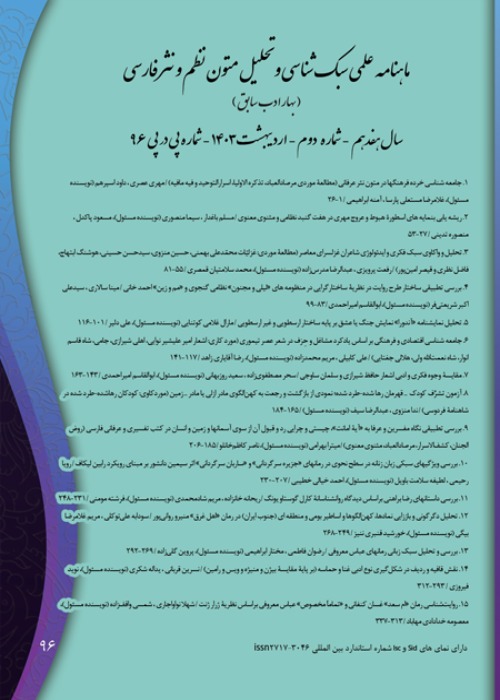Comparative analysis of the subject, words and syntax of prayers and curses of Shahnameh (Case study of the stories of Rostam, Esfandiar and Kamos Keshani)
Shahnameh is one of the most important identity and historical works of Iranians that can be studied from different aspects of mythology, fiction, rhetoric and stylistics. What distinguishes Shahnameh from other works of all times is Ferdowsi"s personal style. In many books and articles, Khorasani style has been discussed, but Ferdowsi"s personal style has received less attention. In this study, in order to understand Ferdowsi"s style and understand his ability to create dialogues, two opposing human discourses, namely prayer and curse, which are manifestations of human emotions and feelings in different situations and situations and are rooted in human sadness and happiness, have been studied.
This research is theoretical and has been done in a descriptive-analytical manner. The study area and society are two stories by Rostam and Esfandiar and Kamus Keshani from Ferdowsi"s Shahnameh by Saeed Hamidian, which was published by Qatreh Publishing.
The prayer propositions in these two stories are 18 bits and the curse propositions are 19 bits. Thus, in the beginning, the content of prayer and cursing propositions is extracted and classified from the verses. The theme of the Shahnameh"s prayers is more seeking happiness and peace, overcoming enemies, longing for heaven and paradise, and curses include calling for the destruction of enemies, cosmic curses, and cursed glories. The real curse, which is the request to destroy the enemies, occurs in a state of rage and anger, and generally on the battlefield, but the curses of the universe and cursed glories appear in a state of sorrow. After examining the content of prayers and curses, the descriptive-analytical method of words, verbs, syntax and sentence arrangement patterns in both types of propositions are described.
Ferdowsi did not follow a specific pattern in the arrangement of sentence components, but by examining and analyzing the data, key and repeated phrases are found that Ferdowsi has used in drawing the two situations of prayer and curse. In the prayer propositions, the key and frequent phrases "without you", "being away from" and "bad luck" are seen, and in the cursed propositions, the phrase "may + ... + prayer verb + may + ... (Wind) »is repeated. Also, in this research, it has been determined that the irony in prayer and curse, as the most colorful literary array, causes more rhetoric of prayer and curse propositions.
- حق عضویت دریافتی صرف حمایت از نشریات عضو و نگهداری، تکمیل و توسعه مگیران میشود.
- پرداخت حق اشتراک و دانلود مقالات اجازه بازنشر آن در سایر رسانههای چاپی و دیجیتال را به کاربر نمیدهد.


